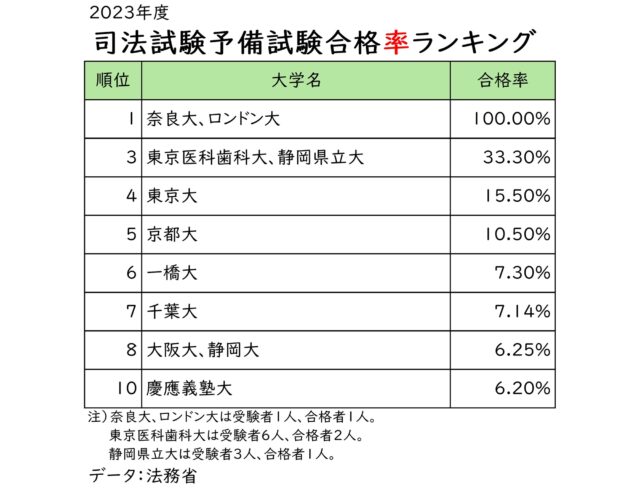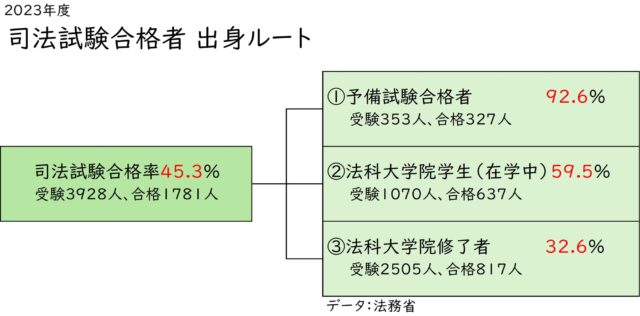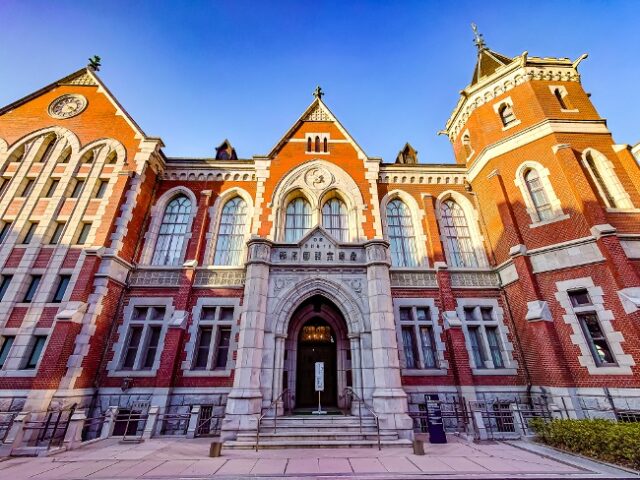I made an interesting ranking.
In 2023, it is a school with a high passing rate for the preliminary bar exam.
① Nara University, University of London 100%, ③ Tokyo Medical and Dental University, Shizuoka Prefectural University 33.3% ④ University of Tokyo 15.5% ⑤ Kyoto University 10.5% ⑥ Hitotsubashi University 7.3% ⑦ Chiba University 7.14% ⑧ Osaka University, Shizuoka University 6.25% ⑩ Keio Keio University: 6.2% (Nara University, University of London: XNUMX examinee, XNUMX passer; Tokyo Medical and Dental University: XNUMX examinees, XNUMX passers; Shizuoka Prefectural University: XNUMX examinees, XNUMX passer) .

In order to be eligible to take the bar exam, a person must, in principle, be enrolled in or have completed a law school. However, even those who do not attend law school due to time constraints or financial reasons can still take the bar exam. This is a system in which those who pass the preliminary bar exam (hereinafter referred to as the "preliminary exam") are eligible to take the bar exam.
So, what about the all-important bar exam? Let's take a look at the latest data.
In 2023, the bar exam passing rate was 45.3%. (3928 people took the exam, 1781 people passed).
Looking at this by route of origin, 92.6) 353% of those who passed the preliminary exam (327 took the exam, 59.5 passed). ② 32.6% of law school students (currently enrolled); ③ 68.4% of law school graduates. By the way, the law schools with the highest bar exam pass rates are 67.2) Kyoto University 60.0%, 59.1) Hitotsubashi University 48.6%, 13) Keio University XNUMX%, XNUMX) Tokyo University XNUMX%, and XNUMX) Kobe University XNUMX%. There were XNUMX law schools that could not accept successful applicants. This is a shame because, based on the track record of passing the bar exam, it becomes clear that those who pass the preliminary exam are far superior to those who have completed law school.

The content of the preliminary exam is to determine whether the applicant has the same academic knowledge as someone who has completed a law school. Therefore, you will not be able to pass unless you have a considerable amount of legal knowledge and application methods. In fact, the entrance exam was quite narrow, and the pass rate in 2023 was 19.0% (2562 people took the exam, 487 people passed). However, these days, many people who are confident in their brains are taking on the challenge.
I would like you to take a look at the schools with the highest pass rates for the preliminary exam that I introduced at the beginning. More than 90% of those who passed the preliminary exam passed the bar exam, and in the near future, more and more people will enter the legal profession from universities without law faculties or law schools, such as Nara University, Tokyo Medical and Dental University, and Shizuoka Prefectural University. It will come.
When and how did they study? The two successful applicants to Tokyo Medical and Dental University are second-year and fourth-year students. Medical students are passing the preliminary exam, which is the shortest route to becoming a lawyer, before taking the national medical examination. In the near future, the two will be qualified as both lawyers and doctors. The alumni of those who passed the preliminary exam include Aoyama Gakuin University, Seikei University, Niigata University, Shizuoka University, and Kumamoto University. These are schools that had law schools, but have stopped accepting applications. On the other hand, there are also graduates from universities unrelated to law schools, such as Tokyo University of Foreign Studies and Mie University.
When we look at the people who passed the preliminary exam by age, demographic, and year of university, we find something surprising. Minimum age: 16 years old, XNUMX person in high school. He is a first or second year high school student. By university year, there were seven first-year students from Tokyo University, five from Keio University, two from Meiji University, and one from Kyoto University.
What should a second-year high school student study to pass the preliminary exam?
There was a precedent. Second-year students at Nada High School will pass the preliminary exam in 2021, and third-year students will pass the bar exam in 22. The following year, he entered the Faculty of Law at the University of Tokyo on recommendation. According to a person close to Nada High School, ``He was an outstanding genius, you could say he was gifted.''
There was another precedent. In the 2010s, third-year students at Keio High School passed the preliminary exam, entered Keio University's Faculty of Law, and then took the bar exam in early July and passed. Moreover, there were two people of different ages, and both passed at the age of 19. This can be said to be the result of a graduate of an affiliated or affiliated high school who does not need to study for entrance exams.

So, why are first-year university students able to pass the preliminary exam? The preliminary exam will be held in late July. As mentioned above, Keio University would be able to take advantage of the ``high school-university connection,'' but at the University of Tokyo, there is only a little less than four months from the end of the entrance exam in late February until the preliminary exam. Being able to pass after such a short period of study is probably gifted.
This is no position for law schools. When the law school system was launched in 2004, the aim was to develop diverse legal professionals who could respond to various events in anticipation of globalization and high-tech technology. Initially, 74 schools were established, but by 2024, 40 schools will cease recruiting. The remaining 34 schools are mainly in the Kanto and Kansai regions, with none in Hokuriku, Koshinetsu, Shikoku and San'in, and only one in Kyushu and Okinawa. In that sense, it is not a bad thing that some of the students who passed the preliminary exam were from Niigata University, Shizuoka University, Seinan Gakuin University, and Kumamoto University, and regional disparities have been corrected as a result.
Furthermore, as the birthrate continues to decline, it is a good thing for the legal profession to see young, talented people aiming to take the preliminary exams and bar exams. However, there is also criticism that it is difficult to compete with the bar exam in a game-like, qualification-maniacal manner, and that it is negative for the legal profession.
The number of candidates taking the preliminary exam, which does not require much money or time, is increasing. You could call it a medicinal charm. If the preparatory exam route is more likely to revitalize the legal profession as a whole than the law school route, the significance of law school education will be obscured. troublesome. (Data provided by the Ministry of Justice)
education journalist
Mr. Tetsuo Kobayashi
Born in Kanagawa Prefecture in 1960.educational journalist.He is the editor of Asahi Shimbun Publishing's "University Ranking" (1994-).His most recent publication is Nihon no Gakureki (Academic Background in Japan) (co-authored with Mr. Toshiaki Tachibana, Asahi Shimbun Publishing).
